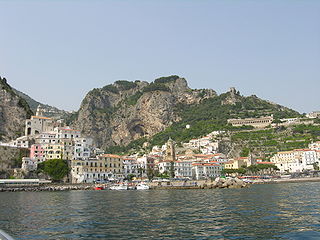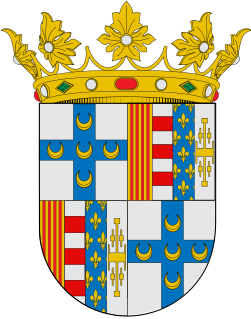Related Research Articles

Amalfi is a town and comune in the province of Salerno, in the region of Campania, Italy, on the Gulf of Salerno. It lies at the mouth of a deep ravine, at the foot of Monte Cerreto, surrounded by dramatic cliffs and coastal scenery. The town of Amalfi was the capital of the maritime republic known as the Duchy of Amalfi, an important trading power in the Mediterranean between 839 and around 1200.

Capri is an island located in the Tyrrhenian Sea off the Sorrento Peninsula, on the south side of the Gulf of Naples in the Campania region of Italy. The main town Capri that is located on the island shares the name. It has been a resort since the time of the Roman Republic.

Positano is a village and comune on the Amalfi Coast, in Campania, Italy, mainly in an enclave in the hills leading down to the coast.

The Amalfi Coast is a stretch of coastline in Tyrrhenian Sea, located in the Gulf of Salerno in the Southern Italy.

Amalfi is town and municipality of the Colombian Andes, northern part of the Central Mountain Range in the Antioquia Department and part of the subregion of Northeastern Antioquia. The territory of Amalfi is bordered by the municipalities of Anorí and Segovia at its north; Segovia, Remedios and Vegachí at the east; Vegachí, Yalí, Yolombó and Gómez Plata at the south and Anorí and Guadalupe at the west. The town is served by Amalfi Airport.

The Duchy of Gaeta was an early medieval state centered on the coastal South Italian city of Gaeta. It began in the early ninth century as the local community began to grow autonomous as Byzantine power lagged in the Mediterranean and the peninsula due to Lombard and Saracen incursions.

The Duchy of Amalfi or the Republic of Amalfi was a de facto independent state centered on the Southern Italian city of Amalfi during the 10th and 11th centuries. The city and its territory were originally part of the larger ducatus Neapolitanus, governed by a patrician, but it extracted itself from Byzantine vassalage and first elected a duke in 958. During the 10th and 11th centuries Amalfi was estimated to have a population of 50,000–70,000 people. It rose to become an economic powerhouse, a commercial center whose merchants dominated Mediterranean and Italian trade in IX and X century, before being surpassed and superseded by the other maritime republics of the North, like Pisa, Venice, and Genoa. In 1073, Amalfi lost its independence, falling to Norman invasion and subsequently to Pisa in 1137.

The Duchy of Naples began as a Byzantine province that was constituted in the seventh century, in the reduced coastal lands that the Lombards had not conquered during their invasion of Italy in the sixth century. It was governed by a military commander (dux), and rapidly became a de facto independent state, lasting more than five centuries during the Early and High Middle Ages. The modern city of Naples remains a significant region of Italy, today.

Gisulf II was the last Lombard prince of Salerno (1052–1077).

Sicard was the Prince of Benevento from 832. He was the last prince of a united Benevento which covered most of the Mezzogiorno. On his death, the principality descended into civil war which split it permanently. He was the son and successor of the Spoletan Sico.

Manso I was the duke of Amalfi (966–1004) and prince of Salerno (981–983). He was the son of Duke Sergius I and the greatest independent ruler of Amalfi, which he controlled for nearly half a century. He is sometimes numbered Manso III.

Medieval Amalfi was ruled, in the tenth and eleventh centuries, by a series of dukes, sometimes called dogi, corresponding with the republic of Venice, a maritime rival throughout the Middle Ages. Before the title of Duke of Amalfi was formally established in 957, various patricians governed the territory. Amalfi established itself as one of the earliest maritime trading powers renowned throughout the Mediterranean, considered for two centuries, the most powerful of the maritime republics.
John II was the duke of Amalfi from 1029 to 1069 with multiple interruptions. He was the son of Sergius II and Maria, sister of Pandulf IV of Capua. He was the last significant duke of Amalfi before the Norman conquest of 1073.

The Lombard Principality of Salerno was a South Italian state, formed in 851 out of the Principality of Benevento after a decade-long civil war. It was centred on the port city of Salerno. Although it owed allegiance at its foundation to the Carolingian emperor, it was de facto independent throughout its history and alternated its allegiance between the Carolingians and their successors in the West and the Byzantine emperors in the east.

Atrani is a city and comune on the Amalfi Coast in the province of Salerno in the Campania region of south-western Italy. It is located to the east of Amalfi, several minutes drive down the coast.
Sergius III was the duke of Amalfi from 1069, when he succeeded his father John II, until his death. He was first appointed co-regent by his father in 1031. He and his father were expelled from Amalfi by his grandmother and uncle, Maria and Manso II, in April or May 1034.
Sergius I was the second Duke of Amalfi and first of the Musco Comite family.
Manso was a Lombard viceduke (vicedux) who ruled the Duchy of Amalfi during the reign of Roger Borsa, the Norman Duke of Apulia. He is known only from his coins: large, copper follari bearing the inscription MANSO VICEDUX on the reverse. Irregular and poor in quality, mostly overstrikes of Salernitan coins, they were originally attributed to Manso of Salerno (981–83).
Giovanna d'Aragona, Duchess of Amalfi (1478–1510) was an Italian aristocrat, regent of the Duchy of Amalfi during the minority of her son from 1498 until 1510. Her tragic life inspired several works of literature, most notably John Webster's play, The Duchess of Malfi.
References
- Skinner, Patricia. Family Power in Southern Italy: The Duchy of Gaeta and its Neighbours, 850-1139. Cambridge University Press: 1995.
| | This biography of an Italian noble is a stub. You can help Wikipedia by expanding it. |
| Preceded by Stephen | Prefect of Amalfi 898 – 914 | Succeeded by Mastalus I |